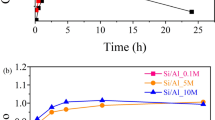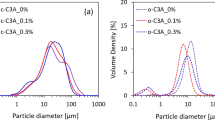Abstract
Unwashed samples of amorphous calcium phosphate (ACP) contain an irreplaceable labile fraction, rich in acid phosphate and low in Ca/P ratio, which is irreversibly lost during the washing process. Native ACP precipitated in the pH range 6.6–10.6 varied in Ca/P molar ratio from 1.18 to 1.50 and in HPO 2−4 /total P from 33.0% to 10.1%. At pH 7.40, native ACP had a Ca/P molar ratio of 1.36±0.02 and contained 22.8 (±2.2)% HPO 2−4 . Unwashed precipitate data could not be attributed to either trapped supernatant Ca2+ and HPO 2−4 or extraneous Na+, Cl−, and CO 2−3 . The amorphous calcium phosphates are recognized as a class of salts having variable chemical but identical glass-like, physicochemical properties. Non-crystalline CaHPO4·xH2O may also be an ACP, especially during early formative stages. At physiological pH, ACP transforms to small platy crystals containing large amounts of readily-replaceable acid phosphate. Washing this surface layer produced chemical alterations in the resultant crystals; unwashed crystals had poorly-crystalline apatitic diffraction patterns but exhibited poorly-resolved infrared spectra intermediate between apatite and octacalcium phosphate. Structural explanations for all these phenomena are discussed, and revised bone and cartilage amorphous/crystalline mineral compositions have been re-calculated.
Résumé
Des échantillons non lavés de phosphate de calcium amorphe (ACP) contiennent une fraction labile, non remplaçable, riche en phosphate acide avec un rapport Ca/P faible: cette fraction est perdue de façon irréversible au cours du lavage. De l'ACP frais, précipité entre pH 6.6–10.6, varie dans un rapport molaire Ca/P de 1.18 à 1.50 et dans un rapport HPO 2−4 /P total de 33.0% à 10.1%. A pH 7.40, de l'ACP frais a un rapport molaire Ca/P de 1.36±0.02 et contient 22.8 (±2.2)% HPO 2−4 . Les résultats obtenus avec du précipité non lavé ne peuvent s'expliquer par du Ca2+ emprisonné et de l'HPO 2−4 ou du Na+, Cl− et CO 2−3 exogènes. Les phosphates de calcium amorphes constituent une classe de sels ayant des caractères chimiques variables et des propriétés physiques identiques, comparables au verre. Le CaHPO4·xH2O non cristallin peut être un ACP, surtout au cours des phases précoces de formation. A des pH physiologiques, l'ACP se transforme en petits cristaux applatis contenant de fortes quantités de phosphate acide facilement remplaçable. Le fait de laver la couche de surface produit un changement chimique dans les nouveaux cristaux: des cristaux non lavés donnent des diagrammes de diffraction d'apatite peu cristallins, ainsi que des spectres infra-rouges peu nets, intermédiaires entre des apatites et du phosphate octocalcique. Des explications structurales sont proposées et les compositions minérales amorphe/cristalline de l'os et du cartilage sont recalculées.
Zusammenfassung
Ungewaschene Proben von amorphem Calciumphosphat (ACP) enthalten eine unersetzliche labile Fraktion, welche reich an saurem Phosphat ist und ein niederes Ca/P-Verhältnis hat und welche während des Waschprozesses unwiderruflich verloren geht. Natives ACP, welches im pH-Bereich 6,6–10,6 ausgefällt wurde, variierte im molaren Ca/P-Verhältnis zwischen 1,18 und 1,50 und in HPO 2−4 /totales P zwischen 33,0 und 10,1%. Bei pH 7,40 hatte natives ACP ein molares Ca/P-Verhältnis von 1,36±0,02 und enthielt 22,8 (±2,2)% HPO 2−4 . Die Werte beim ungewaschenen Niederschlag rühren weder von aus dem Überstand aufgenommenem Ca2+ und HPO2−, noch von außen kommendem Na+, Cl− und CO 2−3 her. Die amorphen Calciumphosphate werden als eine Klasse von Salzen erkannt, welche veränderliche chemische, aber identische glasartige physicochemische Eigenschaften haben. Nicht kristallines CaHPO4·xH2O kann auch ein ACP sein, besonders in den frühen Bildungsstadien. Bei physiologischem pH verwandelt sich ACP in kleine plattenförmige Kristalle, welche große Mengen von leicht ersetzbarem saurem Phosphat enthalten. Das Waschen dieser Oberflächenschicht erzeugte chemische Veränderungen in den resultierenden Kristallen; ungewaschene Kristalle zeigten ein Diffraktionsmuster, das nur schwach demjenigen des kristallinen Aspatites glich, aber ein schlecht aufgelöstes Infrarotspektrum, welches zwischen Apatit und Octocalciumphosphat war. Es werden strukturelle Erklärungen für alle diese Phenomena diskutiert, und revidierte amorph/kristalline Mineralzusammensetzungen von Knochen und Knorpel wurden neu berechnet.
Similar content being viewed by others
References
Bachra, B. N.: Precipitation of calcium carbonates and phosphates from metastable solutions. Ann. N.Y. Acad. Sci.109, 251–255 (1963).
Bachra, B. N., Trautz, O. R., Simon, S. L.: Precipitation of calcium carbonates and phosphates. III. The effect of magnesium and fluoride ions on the spontaneous precipitation of calcium carbonates and phosphates. Arch. oral. Biol.10, 731–738 (1965).
Bernardi, G., Kawasaki, T.: Chromatography of polypeptides and proteins on hydroxyapatite columns. Biochim. biophys. Acta (Amst.)160, 301–310 (1968).
Bienenstock, A., Posner, A. S.: Calculation of the x-ray intensities from arrays of small crystallites of hydroxyapatite. Arch. Biochem.124, 604–607 (1968).
Bocciarelli, D. S.: Morphology of crystallites in bone. Calc. Tiss. Res.5, 261–269 (1970).
Boulet, M., Marier, J. R.: Precipitation of calcium phosphates from solutions at near physiological concentrations. Arch. Biochem.93, 157–165 (1961).
Brown, W. E.: Crystal growth of bone mineral. Clin. Orthop.44, 205–220 (1966).
Chapman, A. C., Thirlwell, L. E.: Spectra of phosphorus compounds. I. The infrared spectra of orthophosphates. Spectrochim. Acta20, 937–947 (1964).
Dallemagne, M. J.: Phosphate and carbonate in bone and teeth. In: Proc. first European bone and tooth symposium (H. J. J. Blackwood, ed.), p. 171–174. Oxford: Pergamon Press 1964.
Eanes, E. D.: Thermochemical studies on amorphous calcium phosphate. Calc. Tiss. Res.5, 133–145 (1970).
Eanes, E. D., Gillessen, I. H., Posner, A. S.: Intermediate states in the precipitation of hydroxyapatite. Nature (Lond.)208, 365–367 (1965).
Eanes, E. D., Gillessen, I. H., Posner, A. S.: Mechanism of conversion of non-crystalline calcium phosphate to crystalline hydroxyapatite. In: Crystal growth (H. S. Peiser, ed.), p. 373–376. Oxford: Pergamon Press 1967.
Eanes, E. D., Posner, A. S.: Kinetics and mechanism of conversion of noncrystalline calcium phosphate to crystalline hydroxyapatite. Trans. N.Y. Acad. Sci.28, 233–241 (1965).
Eanes, E. D., Posner, A. S.: Intermediate phases in the basic solution preparation of alkaline earth phosphates. Calc. Tiss. Res.2, 38–48 (1968).
Fleisch, H., Russell, R. G. G., Bisaz, S., Termine, J. D., Posner, A. S.: Influence of pyrophosphate on the transformation of amorphous to crystalline calcium phosphate. Calc. Tiss. Res.2, 49–59 (1968).
Fowler, B. O.: Infrared spectra of apatites. In: Internat. Symposium on structural properties of hydroxyapatite and related compounds (R. A. Young and W. E. Brown, eds.), chapt. 7. New York: Gordon and Breach in press 1968.
Fowler, B. O., Moreno, E. C., Brown, W. E.: Infrared spectra of hydroxyapatite, octacalcium phosphate and pyrolysed octacalcium phosphate. Arch. oral Biol.11, 477–492 (1966).
Francis, M. D.: The inhibition of calcium hydroxyapatite crystal growth by polyphosphonates and polyphosphates. Calc. Tiss. Res.3, 151–162 (1969).
Francis, M. D., Webb, N. C.: Hydroxyapatite formation from a hydrated calcium monohydrogen phosphate precursor. Calc. Tiss. Res.6, 335–342 (1971).
Francois, P.: Étude de la variation de composition de l'os du rat avec l'age. J. Physiol. (Paris)53, 343–344 (1961).
Gee, A., Deitz, V. R.: Determination of phosphate by differential spectrophotometry. Analyt. Chem.25, 1320–1324 (1953).
Gee, A., Deitz, V. R.: Pyrophosphate formation upon ignition of precipitated basic calcium phosphates. J. Amer. chem. Soc.77, 2961–2965 (1955).
Greenfield, D. J., Eanes, E. D.: Formation chemistry of amorphous calcium phosphates in carbonate containing solutions. Calc. Tiss. Res.9, 152–162 (1972).
Harper, R. A., Posner, A. S.: Measurement of non-crystalline calcium phosphate in bone mineral. Proc. Soc. exp. Biol. (N.Y.)122, 137–142 (1966).
McConnell, D.: The crystal chemistry of carbonate apatites and their relationship to the composition of calcified tissues. J. dent. Res.31, 53–63 (1952).
Newesely, H.: Changes in crystal types of low solubility calcium phosphates in the presence of accompanying ions. Arch. Oral Biol. Spec., Suppl.6, 174–180 (1961).
Nylen, M. U., Eanes, E. D., Termine, J. D.: Molecular and ultrastructural studies of non-crystalline calcium phosphates. Calc. Tiss. Res.9, 95–108 (1972).
Posner, A. S.: Crystal chemistry of bone mineral. Physiol. Rev.49, 760–792 (1969).
Stutman, J. M., Termine, J. D., Posner, A. S.: Vibrational spectra and structure of the phosphate ions in some calcium phosphates. Trans. N. Y. Acad. Sci.27, 669–675 (1965).
Termine, J. D.: Amorphous calcium phosphate: the second mineral of bone. Ph. D. Thesis. New York: Cornell University Medical College 1966.
Termine, J. D., Peckauskas, R. A., Posner, A. S.: Calcium phosphate formationin vitro. II. Effects of environment of amorphous-crystalline transformation. Arch. Biochem.140, 318–325 (1970).
Termine, J. D., Posner, A. S.: Infrared analyses of rat bone: age dependency of amorphous and crystalline mineral fractions. Science153, 1523–1525 (1966).
Termine, J. D., Posner, A. S.: Amorphous/crystalline interrelationships in bone mineral. Calc. Tiss. Res.1, 8–23 (1967).
Termine, J. D., Posner, A. S.: Calcium phosphate formationin vitro. I. Factors affecting initial phase separation. Arch. Biochem.140, 307–317 (1970).
Termine, J. D., Wuthier, R. E., Posner, A. S.: Amorphous-crystalline mineral changes during endochondral and periosteal bone formation. Proc. Soc. exp. Biol. (N.Y.)125, 4–9 (1967).
Urist, M. R., Dowell, T. A.: The newly deposited mineral in cartilage and bone matrix. Clin. Orthop.50, 291–308 (1967).
Vuilleumier, C., Lerch, P.: Étude de la structure, par la diffraction des rayons X et la microscopie électronique, de l'hydroxylapatite calcique et des orthophosphates dits tri-et octocalcique. Helv. chim. Acta49, 663–670 (1966).
Wagner, C.: Theorie der Alterung von Niederschlägen durch Umlösen (Ostwald Reifung). Z. Elektrochem.65, 581–591 (1961).
Walton, A. G., Friedman, B. A., Schwartz, A.: Nucleation and mineralization of organic matrices. J. biomed. Mater. Res.1, 337–354 (1967).
Winand, L.: Étude physicochimique du phosphate tricalcique hydraté et de l'hydroxylapatite. Ann. Chim.62, 941–967 (1961).
Author information
Authors and Affiliations
Rights and permissions
About this article
Cite this article
Termine, J.D., Eanes, E.D. Comparative chemistry of amorphous and apatitic calcium phosphate preparations. Calc. Tis Res. 10, 171–197 (1972). https://doi.org/10.1007/BF02012548
Received:
Accepted:
Issue Date:
DOI: https://doi.org/10.1007/BF02012548




